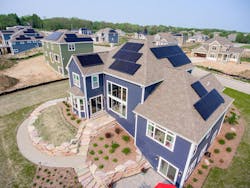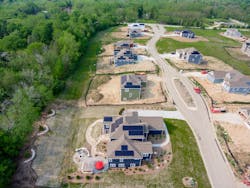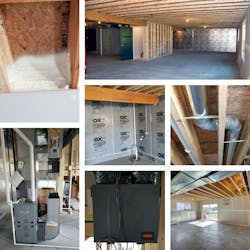Tim O’Brien Homes Goes Big With Net Zero
Tim O’Brien Homes, a green-homes builder in Wisconsin, wanted to do more than construct one-off energy-efficient homes. It wanted to build an entire community of homes certified by the U.S. Department of Energy’s Zero Energy Ready Home Program—the first such development in the state of Wisconsin.
That objective had been driven by a clear-eyed assessment of the market, according to president Tim O’Brien. He felt that if his company built some zero energy homes in a development among code-built homes, his units would be a harder sell.
“If the buyers in our market have some extra money, they put it in upgraded cabinets or a three-car garage—not in energy upgrades,” O’Brien says. “If we did zero energy homes in a community with other builders who were not doing that, it’d be more difficult to convince buyers to pay a little more to have solar.”
So, in mid-2017, along with its investor, Neumann Developments, Tim O’Brien Homes began work on Red Fox Crossing—a subdivision with net-zero electric homes as the standard offering.
Making that neighborhood-wide commitment helped attract the right buying demographic: environmentally conscious individuals looking for efficient, high-performance homes.
“The interest was really strong coming out of the gate,” O’Brien says.
By early 2020, Tim O’Brien Homes closed on the last of the development’s 34 homes—selling about 18 homes per year, compared to its other developments’ typical sales of 12 to 14 homes per year. For the 3- or 4-bedroom homes, ranging from about 1,800 to 3,000 square feet, sales prices ranged from the low $400,000s to just over $600,000.
The builder constructed 85 percent of the development’s homes for clients, with the remaining 15 percent built as spec homes. That’s a marked difference from its typical development breakdown of 60 percent client builds, 40 percent spec.
Trade partners key to net zero ready homes
The success of Red Fox Crossing hinged on having the right partners in place, O’Brien says. The builder’s photovoltaic panel provider, SunVest Solar, helped ensure that each home had exactly the right number of rooftop panels, so it produced neither too much nor too little energy.
In addition, O’Brien points to three vendors as critical partners: Dave Jones, Inc., which provided the HVAC and plumbing systems; Dakota Drywall, which installed the insulation; and Five Star Energy, the development’s energy rater. O’Brien’s company has worked with all three vendors since its start in 2007.
“Having that trio work together, and having a strong relationship between them, is the key to success in a program like this,” O’Brien says.
Their collaboration with the builder and with one another allowed them to quickly learn how to deliver zero energy ready homes—and how to optimize processes along the way, O’Brien says.
“We had like minded partners working together, so the learning curve was shorter, and they were able to do some trial and error to make the systems better.”
For example, with the HVAC equipment, “we had to step it up a bit,” he says.
Mastering HVAC system design for net zero homes
Based on each home’s orientation and the number of its rooms and windows, the energy rater informed the HVAC provider of the required air supply and return in each room. Prior to Red Fox Crossing, Tim O’Brien Homes had used a decentralized return system, in which every room had its own ducted return.
But the builder found that, due to open-concept floor plans, less wall space meant less space for all that ductwork. And more ductwork meant more seams and connections that had to be sealed. All of which affected comfort levels.
Along with Davey Jones, Inc., the builder opted for a centralized return system, running through the middle of the home above the HVAC equipment. “It created a higher level of comfort and greater efficiency,” O’Brien says.
The plumbing also had to pivot. Traditionally, when an occupant turns off hot water, it sits in the pipes, growing cold. And when the occupant turns the hot water back on, that cold water has to run until the heated water flows.
“Not only do you waste water, but you waste energy to heat the water,” O’Brien says.
The builder instead chose a looping system that sizes and distributes the pipes as precisely as possible. The system minimizes both the amount of water sitting in the pipes and the distance that heated water travels, so it gets to the fixture more quickly.
The energy rater also worked closely with the insulator to improve air sealing and tightness.
“It was so important on this journey to have an energy rater willing to innovate, learn, and help our trade partners get better, and to have trade partners willing to persevere,” O’Brien says.
It took the first three to five homes for the team to master the process and deliver the requirements more efficiently, he says.
The ROI of zero energy ready homes
While O’Brien finds that zero energy ready homes cost about 3 to 5 percent more to construct than code homes, the utility bills for Red Fox Crossing homes are about 30 percent lower. O’Brien says he’s so sure of that lower cost he provides homeowners with a five-year guarantee of it.
Now, Tim O’Brien Homes, which won the DOE Housing Innovation Award three years in a row, from 2018 to 2020, is taking all that it learned at Red Fox Crossing and applying it to its new construction. The builder plans to make zero energy ready homes its standard offering by the end of 2022. That will be about 200 new net-zero homes going up each year.


